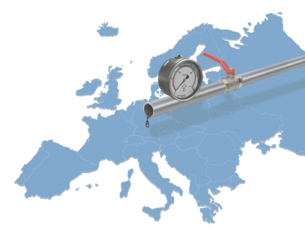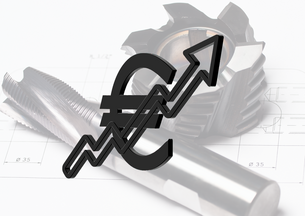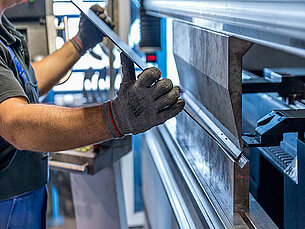Companies in the metalworking industry have to expend a lot of energy,
to process the desired material with the machines.
Especially in the current energy crisis, the question of energy consumption has come to the fore.
In production, companies are therefore increasingly asking themselves what energy their machines use and whether their quotation calculations are correct. In 2020, metal production accounted for around 22% of the energy used in industry, and the company's energy consumption depends on the state of the economy.
When the economy experiences an upswing and thus the demand of a company's product increases, production plants run more frequently and longer.
This leads to the fact that the plants consume more energy.
Even before the machining process in production, there is a high energy input in the manufacture of the raw material.
To produce steel, for example, iron ore and scrap iron are often melted down. This process consumes a lot of energy, as well over 1000 °C are used to melt down the material. In total, one ton of crude steel requires 5711.11 kilowatt hours during production, or 17.73 gigajoules, which is roughly as much energy as is needed by an average four-person household per year. The production of one ton of liquid steel requires around 500 kilowatt hours (kWh) of melting energy. Furthermore, to produce stainless steel, iron ore and coke are first burned, and a chemical reaction then produces iron and carbon dioxide. The iron begins to melt and the resulting slag is removed. What remains is pig iron, which is run through various processes so that "unusable" materials are removed or changed and steel is produced.
An alloy of chromium or nickel, for example, then turns the steel into stainless steel. Aluminum extraction also requires a great deal of energy; energy consumption in aluminum extraction is four times higher than in paper production and ten times higher than in tinplate production. Aluminum is produced, for example, by dissolving white alumina from bauxite using caustic soda, which requires a lot of heat and pressure. In the next step, aluminum hydroxide is turned into aluminum oxide; again, a lot of energy is used, as around 1300 degrees are required to carry out this process. By means of electrolysis, aluminum oxide then becomes aluminum at the end of the process. Approximately 17 kilowatt hours are required for one kilogram of aluminum.
How much energy is used in workpiece production?
After the material has been produced, processing of the material into the desired component follows.
Workpiece production again requires a lot of energy, as this flows into each production and processing step.
Since the material goes through several coarse and fine processing steps, several machines usually have to be used,
which, for example, saw, mill or turn the workpiece into the desired shape.
Subsequently, the workpiece is often ground so that the required shape tolerance and surface quality can be maintained.
Finally, many customers have the component coated or refined (e.g. by heat treatment or glass bead blasting) with the expenditure of energy.
Energy consumption also for workpiece delivery
After the material has been obtained and the component has been produced, the next step is transport, because the goods must finally reach the customer.
Workpieces and materials are usually delivered to the intended recipient, i.e. producer or customer, by trucks or vans.
However, vehicles also consume energy in the form of fuel or electricity. Depending on the distance the vehicle has to travel, the energy consumption varies. However, these energy costs are distributed among all the people who have sent one or more parcels within this delivery. Thus, this energy use has little impact on the energy expenditure of the individual producer or customer.
Does a complaint affect energy use?
Now you have got an impression of the energy use in contract manufacturing. But what effect does a complaint by the customer have on the energy turnover after the order has already been completed by the producer?
A complaint occurs when shape and dimensional tolerances were not adhered to during component manufacture.
Or holes or threads may have been forgotten, or the component may have been damaged in transit or even lost.
In this case, energy is again expended for transport,
because a return delivery to the manufacturer takes place.
If a rework or new production is necessary for a complaint, additional energy must be expended because production facilities must be operated again.
Conclusion
The production of a workpiece, from material production to workpiece delivery to the customer, requires a great deal of energy: production and transport of the material, rough and fine component machining, finishing (e.g. heat treatment, coating) and transport to the customer.
If a workpiece is rejected, the energy input may even double. Furthermore, equipment can be improved in the company to reduce energy consumption. Saving energy is possible with electrical drives. For example, regular maintenance and preventing machines from idling can have a big impact on energy consumption and reduce it. Clients can "simplify" component design so that less raw material is required, machining steps are reduced, or costly (and unnecessary) finishes (e.g., anodizing for optics) are eliminated. Further, clients can weigh how important it is that the component be a single part or whether it is easier to have the component manufactured from multiple pieces, if possible. If the component does not have to be made from a single larger blank of the material, but from individual smaller blocks or bars, the machining does not take as long and less material is wasted in the machining process, thus requiring less energy.
Material production also requires less energy if small and not large blanks have to be produced. Transport routes can also be included in the planning. For example, the producer can find out whether the desired material can be ordered locally and thus shorten the transport route. By using PART FACTORY, you as a company can save energy, since your own production facilities can remain switched off and thus not consume any energy. Or you don't even have to purchase production equipment for a few components. Instead you let other companies, from our producer network manufacture the desired product. Furthermore PART FACTORY helps you to save energy by offering you the possibility to limit production costs and to produce on energy efficient machines.
Try our service!
Convince yourself of our uncomplicated service and make a production inquiry.
You will be surprised how little effort is required.
You can look forward to a high-quality prototype or a corresponding small series on the desired delivery date, which fully corresponds to your production drawing. Give it a try - it's worth it!


![[Translate to English:] PART FACTORY_Energiekosten [Translate to English:] PART FACTORY_Energiekosten](/fileadmin/_processed_/2/5/csm_PART_FACTORY_Energiekosten_bearbeitet_d094480263.jpg)
![[Translate to English:] PART FACTORY_Aluminium [Translate to English:] PART FACTORY_Aluminium](/fileadmin/_processed_/d/7/csm_PART_FACTORY_Aluminium_65573e8054.jpg)
![[Translate to English:] PARTFACTORY_Diagramm_Energieeinsatz [Translate to English:] PARTFACTORY_Diagramm_Energieeinsatz](/fileadmin/_processed_/f/6/csm_PARTFACTORY_Diagramm_Energieeinsatz_a00501af81.png)
![[Translate to English:] PART FACTORY_Kilowatt Stunde [Translate to English:] PART FACTORY_Kilowatt Stunde](/fileadmin/_processed_/0/9/csm_iStock_000007730187XSmall_21c44a792c.jpg)
![[Translate to English:] PART FACTORY_Parket_Return [Translate to English:] PART FACTORY_Parket_Return](/fileadmin/_processed_/f/d/csm_PART_FACTORY_Parket_Return_Gruen_652eb97dd5.png)



![[Translate to English:] E-Mail-Button PART FACTORY [Translate to English:] E-Mail-Button PART FACTORY](/fileadmin/_processed_/2/8/csm_button-email_7338b53c45.png)

![[Translate to English:] PART FACTORY - Kontaktaufnahme [Translate to English:] PART FACTORY - Kontaktaufnahme](/fileadmin/_processed_/2/4/csm_woman-2773007__340_590260e0fe.jpg)